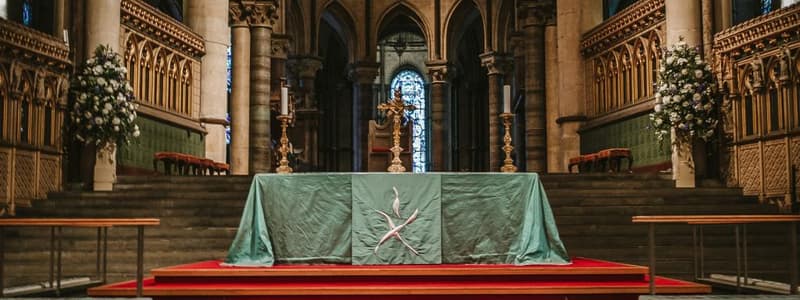Podcast
Questions and Answers
Questions are hidden until you start the quiz
Study Notes
Liturgical Year
- The liturgical year is rooted in history and was developed from the practices of the early Church.
- The evolution of the Christian year was a slower, more complicated process.
- Christianity inherited two great festivals from Judaism: Passover and Pentecost.
- Epiphany, the third great festival, is the most puzzling in terms of origins.
Incarnation Cycle
- Begins with Advent, which lasts for four Sundays.
- Celebrates the coming of Jesus Christ.
- Colors used: purple (representing penitence and preparation) and gold/white (representing majesty and purity).
- Advent wreaths are used, with candles lit each week.
Christmas and Epiphany
- Christmas lasts for 12 days, ending with Epiphany (a moment of great revelation).
- Colors used: gold/white (representing majesty and purity).
- Epiphany commemorates the visit of the wise men to Jesus.
Lent and Easter
- Lent lasts for 40 days (excluding Sundays).
- Represents a time of reflection and penitence.
- Colors used: purple (representing penitence and preparation) and red (representing blood or the fire of renewal and power).
- Celebrates the sacrifice of Jesus and his resurrection.
Ascension and Pentecost
- Ascension Day celebrates Jesus' ascension into heaven.
- Pentecost celebrates the coming of the Holy Spirit.
- Colors used: red (representing blood or the fire of renewal and power) and white (representing purity).
Ordinary Time
- Interrupts the Incarnation Cycle for a few weeks.
- Focuses on the teaching ministry of Jesus.
Kingdom Season
- Celebrates the Kingship of Christ.
- Ends with Christ the King.
- Colors used: red (representing blood or the fire of renewal and power).
Lectionary
- Provides a common pattern of biblical proclamation.
- Serves as a guide for linking children's work, intercessions, hymn choices, and sermons.
- Helps connect Christians across the world and different denominations.
Liturgical Colors
- Purple: represents penitence and preparation.
- Gold/white: represents majesty and purity.
- Red: represents blood or the fire of renewal and power.
Vestments
- Have their roots in biblical times.
- Are symbolic and not worn for fun or to dress up.
- Examples: albs (sacramental garments), chasubiles (sacramental garments), cassocks and surplices (non-sacramental services).
Studying That Suits You
Use AI to generate personalized quizzes and flashcards to suit your learning preferences.


